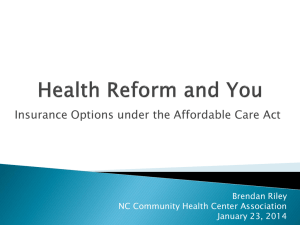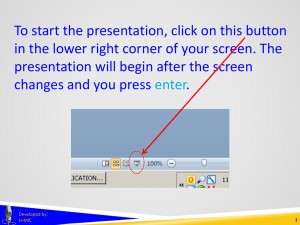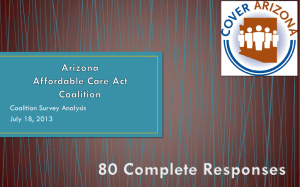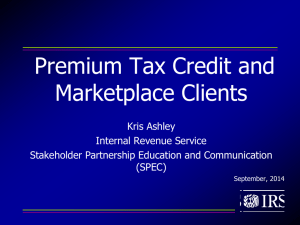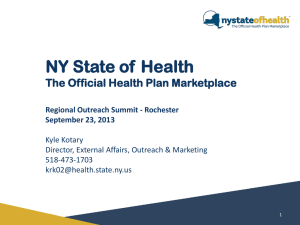Exemptions from the Individual Shared Responsibility Payment
advertisement
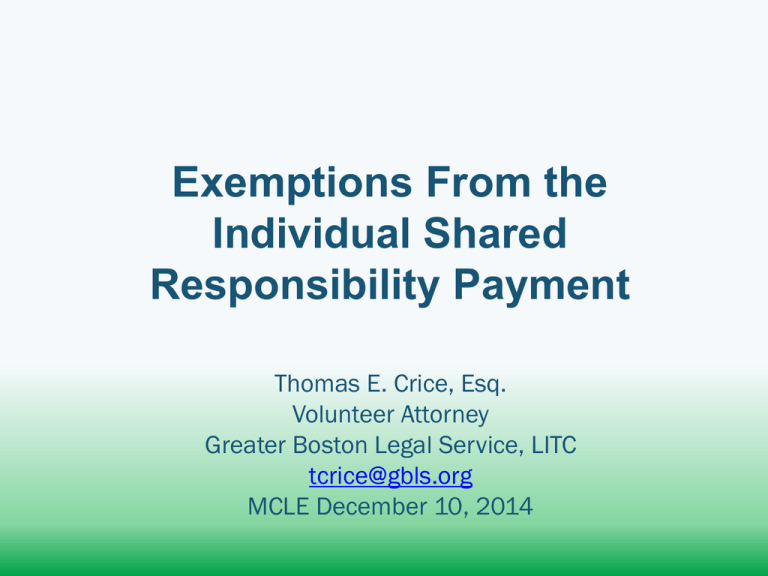
Exemptions From the Individual Shared Responsibility Payment Thomas E. Crice, Esq. Volunteer Attorney Greater Boston Legal Service, LITC tcrice@gbls.org MCLE December 10, 2014 No Good Deed… • Beginning with Tax Year 2014 – On their income tax returns, taxpayers must - Affirm MEC (minimum essential coverage) for the year, OR - Claim an exemption from coverage, OR - Pay the “shared responsibility payment,” aka penalty - If affirming coverage, taxpayers must provide the IRS proof of MEC (minimum essential coverage) o Tax Year 2014 – No proof required but must affirm full or part year coverage as part of tax return o Tax Year 2015 and beyond – The Marketplace will send policy holders Form 1095-A – Private insurers will send policy holders Form 1095-B – Employers who provide coverage will send Form 1095-C 2 …Goes Unpunished • If not affirming coverage taxpayers can still avoid the penalty by claiming an exemption – in the Marketplace, and/or – on their tax returns Note: Exemptions granted by the Marketplace also get reported to the IRS. • So far, there are 19 possible exemptions. To qualify, taxpayers will need to – Figure out which ones apply to them, AND – Document as required, AND – Follow correct procedure 3 The Exemptions (and who can grant them) Source: i8965 (IRS Draft), p. 2 4 Marketplace Exemptions • Applied for during the tax year – Before the tax return is due – But can ask for an exemption retroactively o Up to three years • Must apply on paper, by mail – Processing time could be lengthy • Exemption applications are available on healthcare.gov • Decision on the application is made by the Marketplace • Once granted, must be reported to IRS on filing return – Use form 8965 Part I 5 IRS Exemptions • Applied for after close of the tax year (on tax return) • Can be submitted electronically (e-filed with tax return) • IRS decides whether to grant – Will require that IRS verify some taxpayers – May require documentation be submitted • To claim exemption, file Form 8965 with the return – Complete Part III • If not required to file a return, but filing anyway (i.e., to claim refund or EITC), check box in Part II o Most taxpayers will check the box on Line 7a 6 Draft Form 8965 7 Hardship Exemptions - Marketplace • These exemptions can be obtained ONLY from the Marketplace: – Circumstances prevent you from obtaining qualified coverage – No access to affordable coverage based on projected household income o Exception: This is actually the same as the IRS exemption for “Unaffordability” – Your health insurance policy will not be renewed and you consider the other available plans unaffordable – Ineligible for Medicaid solely because your state does not participate in the ACA Medicaid expansion o Not relevant to Massachusetts • Note: The applications are available online at www.healthcare.gov/fees-exemptions/applyfor-exemption/ 8 Marketplace Hardship Exemptions – The Decision Rule • A hardship exemption must be granted if the Marketplace determines that: 1. The applicant experienced financial or domestic circumstances, including an unexpected natural or human-caused event, such that the applicant had a significant, unexpected increase in essential expenses that prevented him/her from obtaining coverage under a qualified health plan; 2. the expense of purchasing a qualified health plan would have caused him/her to experience serious deprivation of food, shelter, clothing, or other necessities; 3. the applicant experienced other circumstances that prevented him/her from obtaining coverage under a qualified health plan; 9 Marketplace Hardship Exemption – The Criteria • Healthcare.gov representatives are currently saying that a Hardship exemption will be granted if the applicant shows just one of the following: 1. Became homeless 2. Evicted in the last 6 months (or facing eviction or foreclosure) 3. Utility shut-off notice received 4. Domestic violence victim 5. Recent death of a close family member 6. Disaster that resulted in significant property damage (fire, flood, other natural or human caused) 7. Filed for bankruptcy in the last 6 months 8. Substantial debt from unreimbursed medical expenses in the last 24 months 9. High expenses caring for ill, disabled or aging family member 10. Failure of another party to comply with a medical support order for a child (not that party’s tax dependent) who is determined ineligible for Medicaid or CHIP 11. Through an appeals process, applicant is deemed eligible for a Marketplace QHP, PTC, or CSR but was not enrolled 12. Individual health insurance plan was cancelled and applicant believes Marketplace plans are unaffordable 13. Other hardship in obtaining coverage (including for people in AmeriCorps, VISTA and NCCC who are enrolled limited duration or self-funded coverage) 10 Other Marketplace Exemptions • Although these can also be granted by the IRS it’s probably easier for applicants to go through the Marketplace for the following: – Member of health care sharing ministry – Member of federally recognized Indian tribe o Or otherwise eligible for services from an Indian health care provider – Member of religious sect • If granted, the Marketplace certificate number can be used for future years – But must notify Marketplace if status changes – Will still need to file form 8965 with tax return every year 11 Exemptions - IRS • These are granted by the IRS only: – Incarceration o Only applies to period after disposition of charges – U.S. expatriates o Can claim exemption as part of foreign income tax filings – Not a U.S. citizen or alien lawfully present in U.S. – Short coverage gap – “Household income” below the filing threshold – Coverage is “unaffordable” o Exception: Also available from the Marketplace – Same decision rule as IRS (8% of household income) – But is based on “projected income” 12 13 The Short Coverage Gap • No penalty is assessed if the taxpayer went without coverage for “less than three consecutive months” – 3 or more months means no exemptions for any months – Any month with at least one day of coverage counts as coverage for the entire month – If there is more than one gap in a year, only the first one is eligible for this exemption No Coverage Coverage EXEMPT: (for both months) Jan Feb Mar Apr May Jun Jul Aug Sep Oct Nov Dec Sep Oct Nov Dec NOT EXEMPT: (for any months) Jan Feb Mar Apr May Jun Jul Aug Example: Short Coverage Gap • Joe – employed for 3 years with ESI – Laid off March 1, 2014 – coverage lapses – Gets new job, with insurance, on May 30, 2014 – Laid off October 10, 2014 – coverage lapses for rest of year • Result: – Two gaps: o Gap 1: 1 month (April 1-April 30) o Gap 2: 2 months (November 1-December 31) – Only Gap 1 (1 month) qualifies for exemption o Will owe penalty for November, December 14 Household Income Below Tax Filing Threshold • What is a “Household”? – Everyone named on the tax return o Principal filers and their dependents • What is “Income”? – For each person in the Household, add together their “MAGI” (modified adjusted gross income) – Note: If a dependent is not required to file his/her own tax return the taxpayer doesn’t have to include that income. • If this MAGI number is less than the filing threshold for the return then everyone in the Household is exempt from the penalty. 15 Income Tax Filing Thresholds 16 By way of illustration, the 2014 thresholds (under 65) for filing a return are: Exemption: Coverage is Unaffordable • Rule = No penalty payment required if the cost of coverage is more than 8% of Household Income for the year – Household Income is the same as before EXCEPT o Must add to it any health insurance premiums paid pre-tax (“salary reduction plans”) – What is Cost of Coverage? • Case 1: Employer Sponsored Insurance (ESI) – Cost = Employee’s premium for the lowest cost plan (individual and/or family) o Includes amounts paid pre-tax (“salary reduction plans”) • Case 2: Not Eligible for Employer Plan – Cost = lowest cost Bronze level Marketplace plan o Less the Premium Tax Credit the taxpayer is “eligible to receive” 17 Affordability Exemption: Example 1* Sonia Reyes is offered health insurance at work but she doesn’t accept it. • Household Income: $47,000 for a family of four, Sonia, Gilberto (spouse), and two children • Sonia’s premium for employee-only plan: $196/month ($2,350/year) 5% of income • Sonia’s premium for employee plus children: $392/month ($4,700/year) 10% of income • No spousal coverage is offered Do Sonia or her family qualify for exemptions based on affordability? *Slide courtesy of Center on Budget and Policy Priorities 18 Question 1: Is individual coverage affordable?* Test for Sonia (an employee with an offer of ESI) Household Income: $47,000 Sonia’s premium for employee-only plan: $2,350/year (5% of income) Sonia’s premium for employee plus children: $4,700/year (10% of income) No spousal coverage is offered Does the lowest-cost plan that covers only the employee cost more than 8% of household income? • No, the lowest cost employee-only plan is 5% of income. The plan is considered affordable. Sonia does not qualify for exemption on the basis of affordability. *Slide courtesy of Center on Budget and Policy Priorities 19 Question 2: Is family coverage affordable?* 20 Test for the kids (family members with an offer of ESI) Household Income: $47,000 Sonia’s premium for employee-only plan: $2,350/year (5% of income) Sonia’s premium for employee plus children: $4,700/year (10% of income) No spousal coverage is offered Does the lowest-cost plan that covers the kids cost more than 8% of household income? • Yes, the kids are eligible for an exemption because the cost of coverage is greater than 8% of household income. • On Form 8965, the kids will be listed in Part III and Code A will be entered for each month. What about Medicaid or CHIP? The children may be eligible for Medicaid or CHIP, but eligibility for those programs is not taken into account in awarding this exemption. *Slide courtesy of Center on Budget and Policy Priorities Question 3: Is coverage for non-eligible spouse affordable?* Test for Gilberto (spouse without an offer of ESI) Household Income: $47,000 Sonia’s premium for employee-only plan: $2,350/year (5% of income) Sonia’s premium for employee plus children: $4,700/year (10% of income) No spousal coverage is offered Does the lowest-cost bronze plan covering only Gilberto in the Marketplace, after accounting for premium tax credits, cost more than 8% of household income? • His lowest cost bronze plan is $2,000 (4% of household income), taking into account premium tax credits. The plan is considered affordable. He is not eligible for this exemption. *Slide courtesy of Center on Budget and Policy Priorities 21 Affordability Exemption: Example 2 Ana has no insurance offered at work. • Household Income: $40,000 • No dependents or spouse • Lowest cost Bronze plan for $5,000/year • Eligible for $1,700 premium tax credit (Example taken from instructions for IRS Form 8965) Does Ana qualify for exemptions based on affordability? 22 23 Affordability Exemption: Example 2 • Is self-coverage affordable? 𝐴𝑓𝑓𝑜𝑟𝑑𝑎𝑏𝑖𝑙𝑖𝑡𝑦 𝐿𝑖𝑚𝑖𝑡: $40,000 × 0.08 = $3,200 Income Cost of Coverage: $5,000 − Cost of Bronze plan $1,700 = $3,300 Tax Credit $3,300 > $3,200 – Ana is exempt from the penalty if she forgoes coverage. 24 Affordability Exemption: Example 3* Bob and Joan have jobs that offer health coverage to the employee only. • • • • • Household Income: $45,000 Premium cost for Bob: $2,400/year 5.3% of income Premium cost for Joan: $2,100/year 4.6% of income Aggregate cost: $4,500/year 10% of income Neither is offered family coverage that would cover them both for less than 8% of income 12% 10% 8% 6% 10% 4% 2% 5.3% 4.6% 1 2 0% 3 *Slide courtesy of Center on Budget and Policy Priorities They can claim the Code G exemption because the total cost of coverage exceeds 8% of income.
